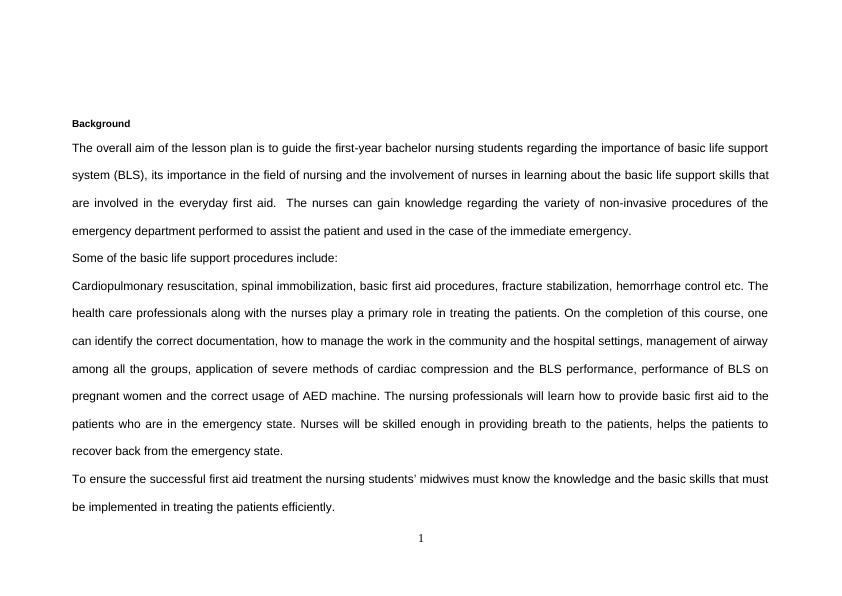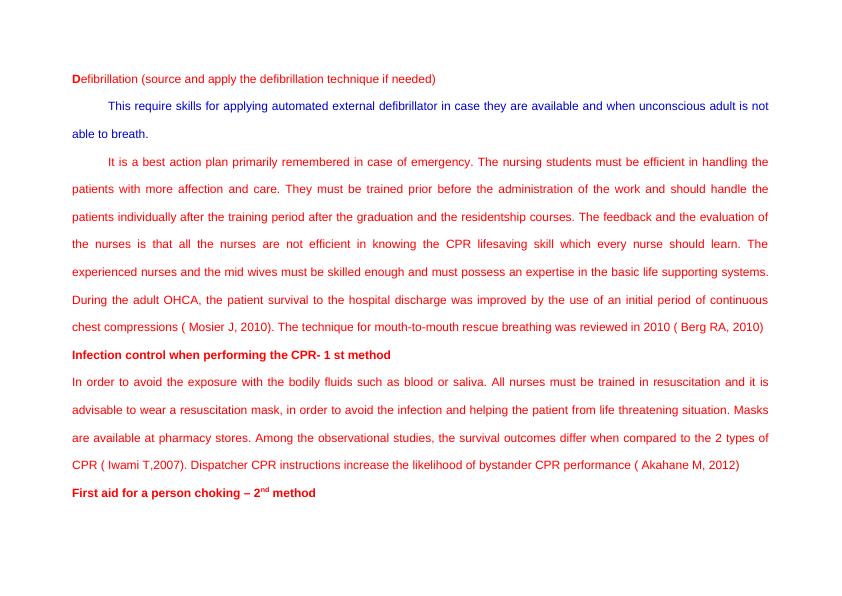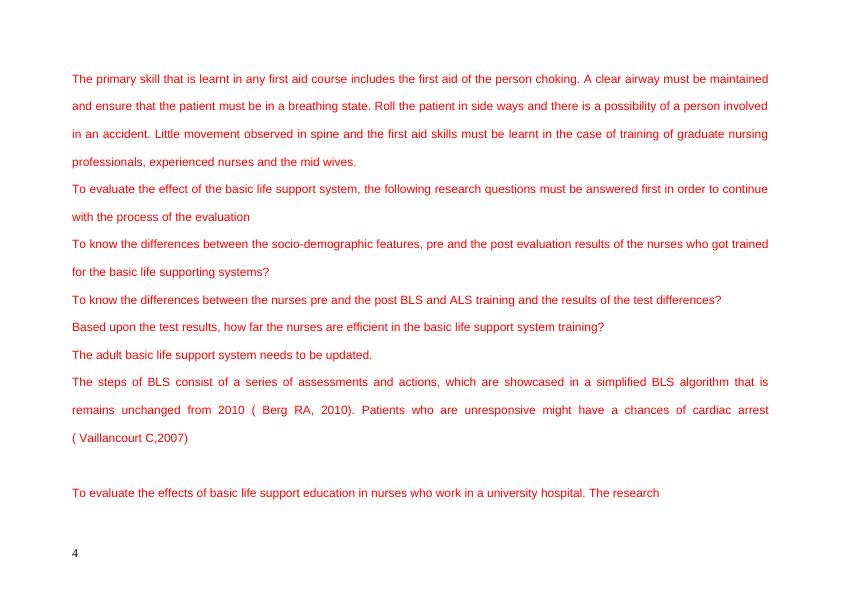Importance of Basic Life Support in Nursing
Added on 2022-12-17
16 Pages3788 Words1 Views
Background
The overall aim of the lesson plan is to guide the first-year bachelor nursing students regarding the importance of basic life support
system (BLS), its importance in the field of nursing and the involvement of nurses in learning about the basic life support skills that
are involved in the everyday first aid. The nurses can gain knowledge regarding the variety of non-invasive procedures of the
emergency department performed to assist the patient and used in the case of the immediate emergency.
Some of the basic life support procedures include:
Cardiopulmonary resuscitation, spinal immobilization, basic first aid procedures, fracture stabilization, hemorrhage control etc. The
health care professionals along with the nurses play a primary role in treating the patients. On the completion of this course, one
can identify the correct documentation, how to manage the work in the community and the hospital settings, management of airway
among all the groups, application of severe methods of cardiac compression and the BLS performance, performance of BLS on
pregnant women and the correct usage of AED machine. The nursing professionals will learn how to provide basic first aid to the
patients who are in the emergency state. Nurses will be skilled enough in providing breath to the patients, helps the patients to
recover back from the emergency state.
To ensure the successful first aid treatment the nursing students’ midwives must know the knowledge and the basic skills that must
be implemented in treating the patients efficiently.
1
The overall aim of the lesson plan is to guide the first-year bachelor nursing students regarding the importance of basic life support
system (BLS), its importance in the field of nursing and the involvement of nurses in learning about the basic life support skills that
are involved in the everyday first aid. The nurses can gain knowledge regarding the variety of non-invasive procedures of the
emergency department performed to assist the patient and used in the case of the immediate emergency.
Some of the basic life support procedures include:
Cardiopulmonary resuscitation, spinal immobilization, basic first aid procedures, fracture stabilization, hemorrhage control etc. The
health care professionals along with the nurses play a primary role in treating the patients. On the completion of this course, one
can identify the correct documentation, how to manage the work in the community and the hospital settings, management of airway
among all the groups, application of severe methods of cardiac compression and the BLS performance, performance of BLS on
pregnant women and the correct usage of AED machine. The nursing professionals will learn how to provide basic first aid to the
patients who are in the emergency state. Nurses will be skilled enough in providing breath to the patients, helps the patients to
recover back from the emergency state.
To ensure the successful first aid treatment the nursing students’ midwives must know the knowledge and the basic skills that must
be implemented in treating the patients efficiently.
1

DRS ABCD stand for?
Danger ( Look for dangers, is there any dangers to the healthcare workers or to the patient)
In this person or first aid provider is required to have skill for identifying danger for them and danger for bystanders. It is
important that one do not put themselves in danger while assisting others.
Response (check for the response if patient is alert or unconscious)
Skill to understand how one can be asked for response and ability to understand conscious and unconscious state.
Send for help (call 000 in case of emergency if needed)
In this stage one should be aware about and have knowledge of whom they should contact in emergency.
Airway (check for the obstructions to airway in lungs)
Skill one need in this is to understand if the person is breathing or not and identifying this through by opening their mouth,
tilting their head and checking breathing. In case breathing is not clear then one needs to be skilled in opening their mouth and
clearing contents from mouth and checking breathing again.
Breathing (check if patient is breathing normally)
Ability to understand chest movement and understanding and ensuring breathing through some other way.
CPR (commence CPR if necessary)
In this individual is required to have proper cardiopulmonary resuscitation that involves 30 compression and 2 breaths.
2
Danger ( Look for dangers, is there any dangers to the healthcare workers or to the patient)
In this person or first aid provider is required to have skill for identifying danger for them and danger for bystanders. It is
important that one do not put themselves in danger while assisting others.
Response (check for the response if patient is alert or unconscious)
Skill to understand how one can be asked for response and ability to understand conscious and unconscious state.
Send for help (call 000 in case of emergency if needed)
In this stage one should be aware about and have knowledge of whom they should contact in emergency.
Airway (check for the obstructions to airway in lungs)
Skill one need in this is to understand if the person is breathing or not and identifying this through by opening their mouth,
tilting their head and checking breathing. In case breathing is not clear then one needs to be skilled in opening their mouth and
clearing contents from mouth and checking breathing again.
Breathing (check if patient is breathing normally)
Ability to understand chest movement and understanding and ensuring breathing through some other way.
CPR (commence CPR if necessary)
In this individual is required to have proper cardiopulmonary resuscitation that involves 30 compression and 2 breaths.
2

Defibrillation (source and apply the defibrillation technique if needed)
This require skills for applying automated external defibrillator in case they are available and when unconscious adult is not
able to breath.
It is a best action plan primarily remembered in case of emergency. The nursing students must be efficient in handling the
patients with more affection and care. They must be trained prior before the administration of the work and should handle the
patients individually after the training period after the graduation and the residentship courses. The feedback and the evaluation of
the nurses is that all the nurses are not efficient in knowing the CPR lifesaving skill which every nurse should learn. The
experienced nurses and the mid wives must be skilled enough and must possess an expertise in the basic life supporting systems.
During the adult OHCA, the patient survival to the hospital discharge was improved by the use of an initial period of continuous
chest compressions ( Mosier J, 2010). The technique for mouth-to-mouth rescue breathing was reviewed in 2010 ( Berg RA, 2010)
Infection control when performing the CPR- 1 st method
In order to avoid the exposure with the bodily fluids such as blood or saliva. All nurses must be trained in resuscitation and it is
advisable to wear a resuscitation mask, in order to avoid the infection and helping the patient from life threatening situation. Masks
are available at pharmacy stores. Among the observational studies, the survival outcomes differ when compared to the 2 types of
CPR ( Iwami T,2007). Dispatcher CPR instructions increase the likelihood of bystander CPR performance ( Akahane M, 2012)
First aid for a person choking – 2nd method
This require skills for applying automated external defibrillator in case they are available and when unconscious adult is not
able to breath.
It is a best action plan primarily remembered in case of emergency. The nursing students must be efficient in handling the
patients with more affection and care. They must be trained prior before the administration of the work and should handle the
patients individually after the training period after the graduation and the residentship courses. The feedback and the evaluation of
the nurses is that all the nurses are not efficient in knowing the CPR lifesaving skill which every nurse should learn. The
experienced nurses and the mid wives must be skilled enough and must possess an expertise in the basic life supporting systems.
During the adult OHCA, the patient survival to the hospital discharge was improved by the use of an initial period of continuous
chest compressions ( Mosier J, 2010). The technique for mouth-to-mouth rescue breathing was reviewed in 2010 ( Berg RA, 2010)
Infection control when performing the CPR- 1 st method
In order to avoid the exposure with the bodily fluids such as blood or saliva. All nurses must be trained in resuscitation and it is
advisable to wear a resuscitation mask, in order to avoid the infection and helping the patient from life threatening situation. Masks
are available at pharmacy stores. Among the observational studies, the survival outcomes differ when compared to the 2 types of
CPR ( Iwami T,2007). Dispatcher CPR instructions increase the likelihood of bystander CPR performance ( Akahane M, 2012)
First aid for a person choking – 2nd method

The primary skill that is learnt in any first aid course includes the first aid of the person choking. A clear airway must be maintained
and ensure that the patient must be in a breathing state. Roll the patient in side ways and there is a possibility of a person involved
in an accident. Little movement observed in spine and the first aid skills must be learnt in the case of training of graduate nursing
professionals, experienced nurses and the mid wives.
To evaluate the effect of the basic life support system, the following research questions must be answered first in order to continue
with the process of the evaluation
To know the differences between the socio-demographic features, pre and the post evaluation results of the nurses who got trained
for the basic life supporting systems?
To know the differences between the nurses pre and the post BLS and ALS training and the results of the test differences?
Based upon the test results, how far the nurses are efficient in the basic life support system training?
The adult basic life support system needs to be updated.
The steps of BLS consist of a series of assessments and actions, which are showcased in a simplified BLS algorithm that is
remains unchanged from 2010 ( Berg RA, 2010). Patients who are unresponsive might have a chances of cardiac arrest
( Vaillancourt C,2007)
To evaluate the effects of basic life support education in nurses who work in a university hospital. The research
4
and ensure that the patient must be in a breathing state. Roll the patient in side ways and there is a possibility of a person involved
in an accident. Little movement observed in spine and the first aid skills must be learnt in the case of training of graduate nursing
professionals, experienced nurses and the mid wives.
To evaluate the effect of the basic life support system, the following research questions must be answered first in order to continue
with the process of the evaluation
To know the differences between the socio-demographic features, pre and the post evaluation results of the nurses who got trained
for the basic life supporting systems?
To know the differences between the nurses pre and the post BLS and ALS training and the results of the test differences?
Based upon the test results, how far the nurses are efficient in the basic life support system training?
The adult basic life support system needs to be updated.
The steps of BLS consist of a series of assessments and actions, which are showcased in a simplified BLS algorithm that is
remains unchanged from 2010 ( Berg RA, 2010). Patients who are unresponsive might have a chances of cardiac arrest
( Vaillancourt C,2007)
To evaluate the effects of basic life support education in nurses who work in a university hospital. The research
4

End of preview
Want to access all the pages? Upload your documents or become a member.
Related Documents
Importance of CPR in Nursing Practicelg...
|8
|834
|52
Safety and Protection in the Workplacelg...
|6
|1396
|37
Lesson Plan on Basic Life Support (BLS)lg...
|16
|3377
|327
Sample Assignment on Nursing (DOC)lg...
|13
|3857
|123
Performing Basic Life Support: A Teaching Guide for Nursing Studentslg...
|15
|3220
|420
Evidences based on Cardiopulmonary Resuscitation - PDFlg...
|12
|3934
|90